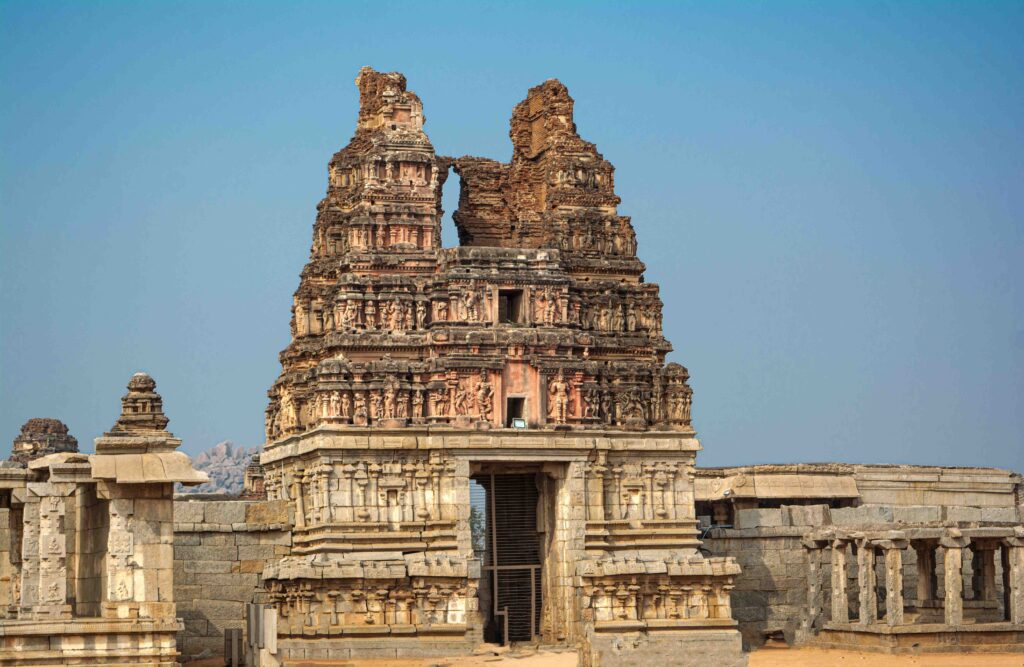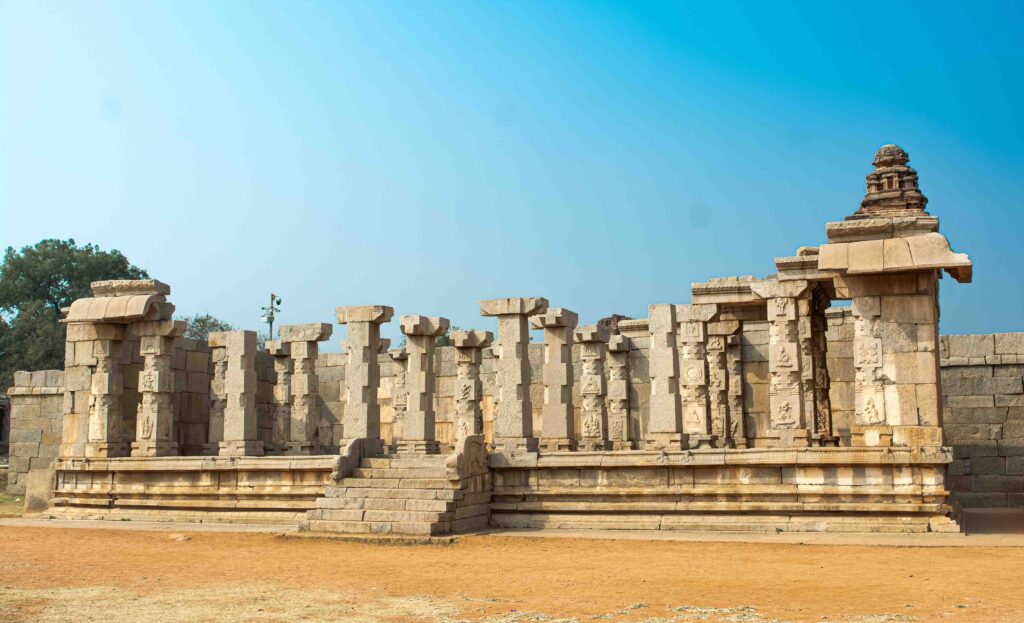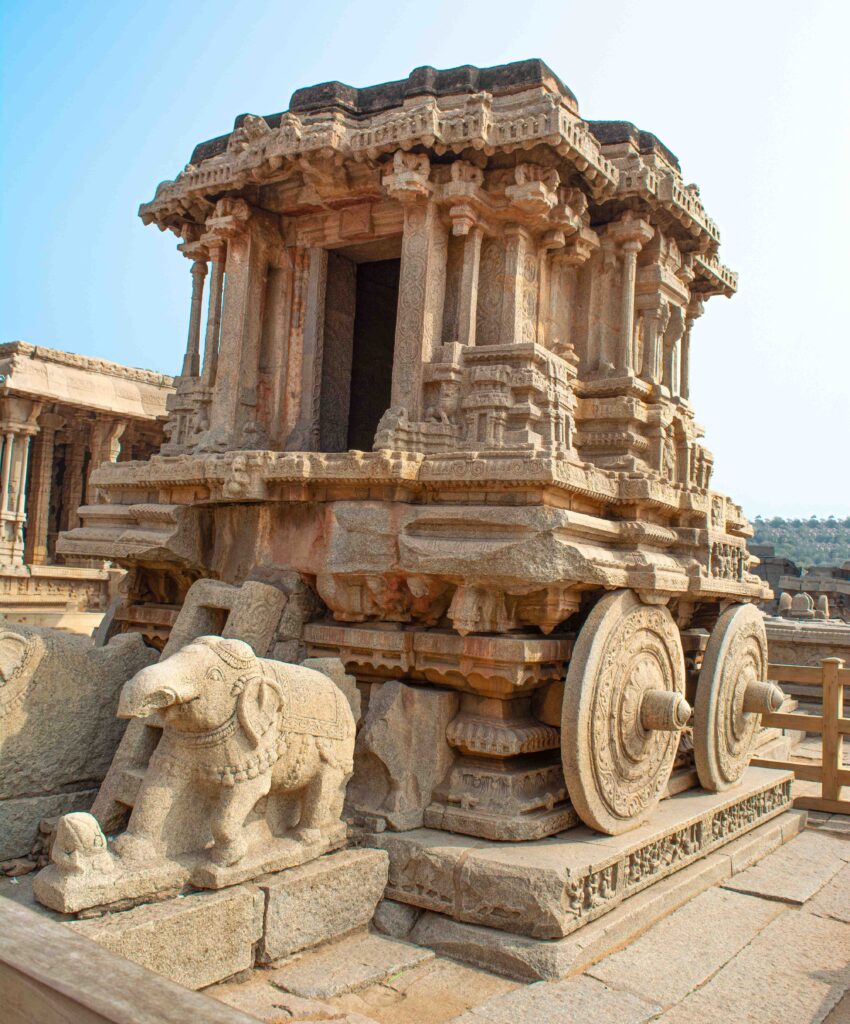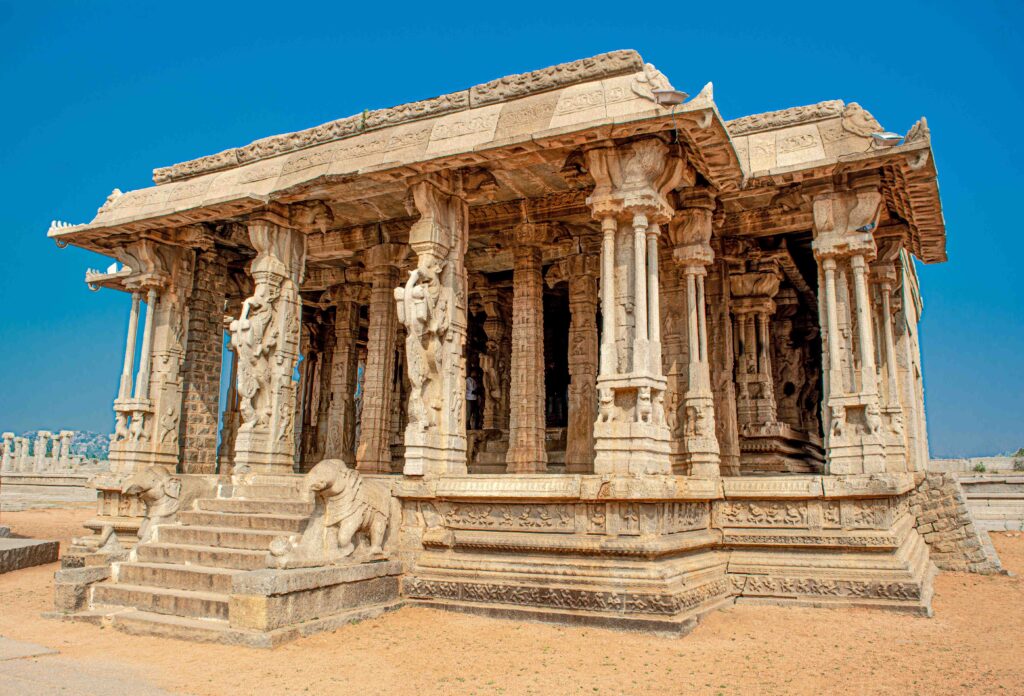Harmony in Stone: Unveiling the Magnificence of Vijaya Vittala Temple in Hampi
Situated amidst the exquisite ruins of Hampi, the Vijaya Vittala Temple emerges as a symbol of artistic brilliance and spiritual reverence. A testament to the magnificence of the Vijayanagara Empire, this temple stands as a living relic, inviting travelers to embark on a journey through time. In this exploration, we delve into the historical importance, construction marvels, and the profound significance that makes Vijaya Vittala Temple an architectural jewel in the heart of Karnataka.

Historical Importance:
The Vijayanagara Legacy:
Constructed during the reign of King Krishnadevaraya in the 16th century, Vijaya Vittala Temple represents the height of the Vijayanagara Empire’s cultural and religious achievements. The empire, known for its strategic brilliance and artistic patronage, reached its zenith during Krishnadevaraya’s rule. The temple, dedicated to Lord Vittala, emerged as a center for spiritual devotion, cultural celebrations, and architectural innovation.
Religious Significance:
Vijaya Vittala Temple is devoted to Lord Vittala, an incarnation of Lord Vishnu. The deity is revered as the preserver of the universe, embodying qualities of goodwill and cosmic order. Pilgrims and devotees flocked to this sacred site to seek blessings, partake in rituals, and witness the divine in the complex details of the temple’s architecture.
Construction and Layout:
Architectural Marvels:
The temple complex is a vast canvas of architectural excellence, showcasing the Dravidian style construction that flourished during the Vijayanagara era. The main entrance, marked by a towering gopuram, invites visitors into a world where every stone tells a story. The Mahamandapa, or the main hall, greets visitors with its remarkable musical pillars, a symphony in stone that resonates with celestial melodies when gently tapped.

Mahamandapa:
The Mahamandapa, also known as the main hall, is proof of the architectural brilliance of the Vijayanagara Empire. As one enters the Mahamandapa, they are immediately greeted by a symphony of intricately carved pillars and walls. Each pillar is a masterpiece, adorned with detailed sculptures depicting mythological stories, divine beings, and celestial scenes. The central ceiling of the Mahamandapa is often an ornate structure featuring a lotus-like design. Surrounding the central area are pillared corridors that further showcase the architectural finesse of the Mahamandapa. Within the Mahamandapa, there are designated spaces for various rituals and ceremonies.

Mystique of Vijaya Vittala’s Musical Pillars:
i. Unique Acoustic Phenomenon: One of the most enchanting features of the Mahamandapa is the set of musical pillars that grace the hall. These pillars, when struck, produce distinct musical notes, creating a phenomenon that has fascinated visitors for centuries. Each pillar resonates with a different musical tone, transforming the temple into a divine concert hall.
ii. Material Composition: The musical pillars are made of solid granite, showcasing the advanced knowledge of acoustics possessed by the Vijayanagara architects. The specific composition of the stone and the craftsmanship involved in carving these pillars contribute to the unique sound-producing capabilities.
iii. Artistic Carvings: Beyond their acoustic properties, the musical pillars are a testament to the artistic mastery of the Vijayanagara artisans. The pillars are adorned with intricate carvings, featuring divine figures, mythical creatures, and ornate patterns that enhance the visual appeal of these extraordinary structures.
iv. Musical Notes: The musical notes produced by the pillars are said to mimic the sounds of traditional musical instruments such as the flute, tabla, and mridangam. Visitors are often encouraged to gently tap the pillars to experience the ethereal music that resonates within the hall.
v. Cultural Significance: The musical pillars of Vijaya Vittala Temple hold immense cultural significance. They symbolize the intersection of art, science, and spirituality—a harmonious blend that defines the cultural ethos of the Vijayanagara Empire. The ability to produce music is considered a divine attribute, and these pillars stand as a unique expression of devotion and ingenuity.
Stone Chariot:
One of the most iconic features of the temple is the Stone Chariot, an exquisite sculpture intricately carved from granite. The Stone Chariot is a finely crafted structure made entirely of granite. It is a representation of a chariot dedicated to Garuda, the mythical eagle, and Vahana (i.e., vehicle) of Lord Vishnu. The chariot is adorned with detailed carvings, depicting mythical creatures, warriors, and floral motifs. The level of detail on the stone surface is a display of the exceptional craftsmanship of the Vijayanagara artisans.
Uniquely, the Stone Chariot is not fixed to the ground; it is a standalone structure. The wheels of the chariot are noteworthy for their precision and detailing. They are finely carved with concentric circles and spokes, showcasing the skill of the sculptors who crafted them. The Stone Chariot is located within the Vijaya Vittala Temple complex, positioned in a way that aligns with the sanctum. The Stone Chariot is often regarded as an emblem of Vijayanagara architecture.
The Stone Chariot at Vijaya Vittala Temple is not just a static monument; it is a living testament to the rich cultural heritage and artistic ingenuity of the Vijayanagara Empire. Its intricate carvings, symbolic representation, and standalone presence make it an essential part of the architectural and spiritual narrative of Hampi.

Ranga Mantapa:
The Ranga Mantapa, the central hall, is a mesmerizing space supported by massive granite pillars. Each pillar is a masterpiece, narrating tales from Hindu mythology through detailed carvings. The hall served as a venue for cultural events, dance performances, and religious ceremonies, fostering a connection between art and spirituality.
Kalyana Mantapa:
The Kalyana Mantapa, or the ceremonial wedding hall, stands as a testament to the luxury and cultural magnificence of the Vijayanagara Empire. Its pillars depict scenes from the Ramayana and Mahabharata, capturing the essence of these timeless epics.

Garuda Shrine:
Within the temple complex, a shrine dedicated to Garuda, the divine eagle and mount of Lord Vishnu, stands as a symbol of devotion. Detailed carvings of Garuda in various poses adorn this sacred space, adding another layer of divine energy to the surroundings.
Architectural Splendors:
Dravidian Influence:
Vijaya Vittala Temple exemplifies the Dravidian style of architecture, characterized by its pyramid-shaped towers, intricately carved pillars, and emphasis on symmetry. The temple seamlessly integrates with the natural landscape of Hampi, creating a harmonious blend of human creativity and the divine design of the Earth.
Intricate Carvings:
The temple’s pillars and walls are adorned with an abundance of intricate carvings, depicting gods, goddesses, mythological tales, and celestial beings. The craftsmanship reflects the artistic prowess of the Vijayanagara artisans who poured their devotion into every chisel stroke, creating a visual narrative that transcends time.
Significance:
Spiritual Reverence:
Vijaya Vittala Temple is more than a testament to architectural genius; it is a sanctuary of spiritual resonance. Pilgrims and visitors alike experience a deep connection with the divine as they walk the hallowed halls, each step echoing with the sacred hymns of the past.
Cultural Heritage:
The temple stands as a living archive of the Vijayanagara Empire’s cultural and artistic heritage. It is a repository of stories, traditions, and artistic expressions that defined an era of prosperity and enlightenment.
Tourist Attraction:
In the contemporary context, Vijaya Vittala Temple draws tourists, historians, and art enthusiasts from across the globe. Its architectural magnificence and historical significance contribute to its status as a UNESCO World Heritage site.
Vijaya Vittala Temple in Hampi transcends the boundaries of time, inviting visitors to witness the intersection of human creativity and divine inspiration. As we wander through its sacred precincts, we are not merely exploring an ancient structure; we are traversing the footsteps of a civilization that left an indelible mark on the landscape of South India. The temple, with its musical pillars, stone chariot, and intricate carvings, whispers tales of devotion, cultural richness, and the enduring spirit of a bygone era. In Hampi’s Vijaya Vittala Temple, the stones harmonize to create a symphony that resonates through the ages—a melody that beckons us to listen, to appreciate, and to be inspired by the enduring beauty of human expression.
| Related Posts: |
 |
Weekend Getaway To Hampi, A UNESCO World Heritage Site
Hampi, a UNESCO world heritage site situated along the riverside of Tungabhadra in the Karnataka state of India. It is around 440 Km from Silicon city, Bangalore…. |
 |
Skiplagging: A Sneaky Way to Save Money on Flights
Skiplagging, also known as hidden city ticketing, is a travel strategy where passengers book a flight with a layover at their intended destination. Instead of taking the connecting flight to the final stop, they disembark……..
|
royalty free images, Royalty-Free Images, Royalty-Free Images, Royalty-Free Images, Royalty-Free Images, Royalty-Free Images royalty free image sources, free images, free picturs, free hotos, stock images
vital vijaya temple,vijaya vittala temple timings,vijaya vittala temple built by,vijaya vittala temple photos,vijaya vittala devasthana,vijaya vittala devalaya,vijaya vittala temple history,vijaya vittala temple images,vijaya vittala temple architecture,vijaya vittala temple hampi,information about vijaya vittala temple,,vijaya vittala temple musical pillars,vijaya vittala temple location,vijaya vittala temple hampi timings,,history of vijaya vittala temple,vijaya vittala temple complex,vijaya vittala temple closing time,vijaya vittala temple entry charges,vijaya vittala temple distance,vijaya vittala mandir mantralayam







This webpage is phenomenal. The brilliant data reveals the maker’s interest. I’m awestruck and expect further such astonishing sections.
Wonderful web site Lots of useful info here Im sending it to a few friends ans additionally sharing in delicious And obviously thanks to your effort
Nice blog here Also your site loads up fast What host are you using Can I get your affiliate link to your host I wish my web site loaded up as quickly as yours lol
Thanks .. We are using hosting services from Hostinger .. You can click on our Invite link and check out their services >>Hostinger Invite<<
Hey there You have done a fantastic job I will certainly digg it and personally recommend to my friends Im confident theyll be benefited from this site